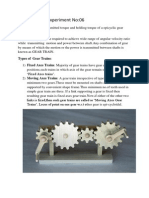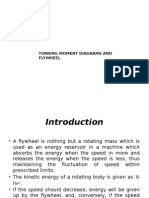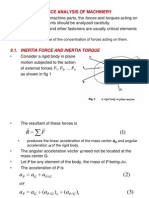Flywheels: 10.1. Flywheel Size
Flywheels: 10.1. Flywheel Size
Uploaded by
addisudagneCopyright:
Available Formats
Flywheels: 10.1. Flywheel Size
Flywheels: 10.1. Flywheel Size
Uploaded by
addisudagneOriginal Title
Copyright
Available Formats
Share this document
Did you find this document useful?
Is this content inappropriate?
Copyright:
Available Formats
Flywheels: 10.1. Flywheel Size
Flywheels: 10.1. Flywheel Size
Uploaded by
addisudagneCopyright:
Available Formats
10.
FLYWHEELS
A flywheel is an energy-storage device which acts as a
smoothing element in a dynamical power transmission circuit.
A flywheel is a power filtering device, which stores excess
energy and delivers the excess energy when required.
10.1. FLYWHEEL SIZE
Fig 1 shows a flat circular disk type flywheel attached to a motor
shaft.
) 1 (
2
1
2
e I E =
1
Energy is stored in a flywheel
by speeding it up or energy is
delivered by a flywheel by
slowing it down.
The kinetic energy of a
flywheel which rotates at e
rad/s is
Energy stored is linearly dependent on the flywheel mass
moment of inertia I , and quadratically dependent on angular
velocity e.
Flywheel must change its velocity in-order to store or deliver
energy.
Hence, the relation between the energy change and the velocity
change is:
where the subscript 1 and 2 designate the minimum and maximum
conditions, respectively.
The average speed of the flywheel, designated by e
av
, is
Defining the coefficient of speed fluctuation as
( ) ) 2 (
2
2
1
2
2 1 2
e e = = A
I
E E E
) 3 (
2
1 2
e e
e
+
=
av
) 4 (
1 2
av
s
C
e
e e
=
2
The energy change is now written as
Substituting for e
2
-e
1
in terms of e
av
, the energy change is given
to be
In many practical applications, the required torque is time-
dependent with a peak-torque requirement only for a very short
duration.
Eg. Punch presses, molding machines, etc.
in such applications, it is a waste to provide motors that deliver the
peak-torque requirement.
better to use motors of smaller capacity by using flywheels
alongside.
( )
( ) ( )
( ) ) 5 (
2
2
1 2
1 2 1 2
2
1
2
2 1 2
e e e
e e e e
e e
=
+ =
= = A
av
I
I
I
E E E
) 6 (
2
1 2 av s
I C E E e =
3
10.2. ENERGY OUTPUT TORQUE
An engine shaft output torque variation, in four stroke engines,
for 720
o
of the crank angle is shown in fig 2 below.
The resisting torque which the engine is driving is represented
by T
av
where T
av
= T
L
, T
L
being the load torque.
The shaded area under the T-u curve represents the work which
either increases or decreases the kinetic energy of the system
by causing decrease or increase in the crank shaft speed.
4
The increase or decrease of the speed depends upon the inertia
of the system which is mainly due to mass of the flywheel.
Control of the crankshaft speed is obtained from the flywheel.
For a flywheel mounted on the drive shaft or crankshaft as
shown in fig 2, from Newtons law of motion
where I is the moment of inertia of the flywheel, and
T-T
L
is the excess torque available in case of
T>T
L
, or torque to be supplied by the
flywheel in case T < T
L
.
Noting that
) 8 (
,
) 7 (
o
o
I T T
or
I T
L
=
=
) 9 ( e e u o d d =
5
Equation (8) can be written as
Integrating between certain limits u
1
and u
2
, we obtain
The term represents the shaded area under the T-
u curve which is normally evaluated graphically.
Positive area of the torque versus crank angle diagram
represent regions in the engine cycle where work is done to
increase flywheel speed, and negative areas represent the
energy taken away from the flywheel thereby decreasing the
speed of the flywheel.
( ) ) 11 (
) 10 (
e e u
u
e
e
d I d T T
or
d
d
I T T
L
L
=
=
( ) ( ) ) 12 (
2
2
1
2
2
2
1
e e u
u
u
=
}
I
d T T
L
( ) u
u
u
d T T
L
}
2
1
6
The locations of the maximum and minimum speeds, e
2
and e
1
respectively, can be determined by inspection from the torque
diagram.
That is between the end of the first loop and the beginning of
seventh loop.
Between which positions the value of (T-T
L
)u is maximum.
From the T-u diagram we have
where A is the area under the T-u curve between u
1
and u
2
.
( )
) 14 (
,
) 13 (
2
2
2
1
2
2 1 2
av s
I C A
or
I
A E E E
e
e e
=
= = = A
7
Representing the crankshaft speed in rpm,
for a given average speed of the flywheel in rpm, the inertia of
the flywheel is determined from
Flywheels are usually of two types: disc and rim type.
For the disc type flywheel,
where W = mg, and d = 2r.
) 15 (
91
1
60
4
2
2
2 2
n I C
n
I C A
s
s
~
=
t
) 16 (
91
2
n C
A
I
s
=
) 17 (
8
1
2
1
2 2
Wd
g
mr I = =
8
For the rim type flywheel,
where, k is the radius of gyration of the rim.
Usually, k can be taken as the mean radius of the flywheel rim,
in which case
) 18 (
2
mk I =
) 19 (
4
2
2 2
g
Wd
mr mk I
m
m
= = =
9
You might also like
- UNIT OPERATIONS - II (Heat and - K. A. GAVHANE PDFDocument477 pagesUNIT OPERATIONS - II (Heat and - K. A. GAVHANE PDFRik Sahoo77% (73)
- Study of a reluctance magnetic gearbox for energy storage system applicationFrom EverandStudy of a reluctance magnetic gearbox for energy storage system applicationRating: 1 out of 5 stars1/5 (1)
- Lecture 2. Refrigeration CyclesDocument8 pagesLecture 2. Refrigeration CyclesaddisudagneNo ratings yet
- Velocity Analysis of LinkagesDocument23 pagesVelocity Analysis of Linkagesaddisudagne67% (3)
- Formula GeotechnicalDocument22 pagesFormula GeotechnicaldmeharyNo ratings yet
- DKD R 6 2 t5 eDocument9 pagesDKD R 6 2 t5 eSebas BuitragoNo ratings yet
- Turning Moment PresentationDocument130 pagesTurning Moment PresentationvinothNo ratings yet
- Flywheel 1Document137 pagesFlywheel 1Prasad varnekarNo ratings yet
- Chapter 3 FlywheelDocument14 pagesChapter 3 Flywheelpixelo09No ratings yet
- Outcome 1 T 3Document7 pagesOutcome 1 T 3Akib SheikhNo ratings yet
- Epicyclic Gear Train Write UpDocument8 pagesEpicyclic Gear Train Write UpkulkajinkyaNo ratings yet
- TM DiagramsDocument7 pagesTM DiagramsblackmechanicalpantherNo ratings yet
- G.H. Raisoni College of EngineeringDocument34 pagesG.H. Raisoni College of Engineeringnikhil_0401No ratings yet
- TOM Unit-3 Force AnalysisDocument44 pagesTOM Unit-3 Force AnalysisRahulNo ratings yet
- Turning Moment Diagram & FlywheelDocument88 pagesTurning Moment Diagram & FlywheelAvinash Jayashankar100% (5)
- Mechanics of Machines - Dda 3043 Power Transmission System: Gear SystemDocument20 pagesMechanics of Machines - Dda 3043 Power Transmission System: Gear SystemNURUL SYUHADA BT ISMAIL HAJAR100% (1)
- Crank Effort DiagramsDocument4 pagesCrank Effort DiagramsDirajen PMNo ratings yet
- FlywheelsDocument33 pagesFlywheelsbijinder06No ratings yet
- ME 361 Unit 6Document53 pagesME 361 Unit 6Dennis ArhinNo ratings yet
- FlywheelsDocument33 pagesFlywheelsKaranSinghNo ratings yet
- Dynamics of Machines - GearsDocument0 pagesDynamics of Machines - Gears10494214No ratings yet
- Flywheel 2Document6 pagesFlywheel 2hassaneabdo2020No ratings yet
- Turning Moment DiagramDocument13 pagesTurning Moment Diagramjorgecarranza6143No ratings yet
- Turning Moment Diagram FlywheelDocument88 pagesTurning Moment Diagram FlywheelJose Antonio Castillo GonzálezNo ratings yet
- Turning Moment Diagrams and FlywheelDocument6 pagesTurning Moment Diagrams and Flywheelvsanthanam0% (1)
- Gear Trains: 8.1. Angular Velocity RatioDocument16 pagesGear Trains: 8.1. Angular Velocity RatioaddisudagneNo ratings yet
- Speed Control OF WIND TURBINEDocument4 pagesSpeed Control OF WIND TURBINESHADDOWWNo ratings yet
- Chapter 1 Lecturer - Gear DriveDocument46 pagesChapter 1 Lecturer - Gear Drivehamry0% (1)
- Dom SolvedDocument49 pagesDom SolvedRAJESH. RNo ratings yet
- Flywheel HandoutDocument5 pagesFlywheel Handoutamanuelfitsum589No ratings yet
- FlywheelDocument62 pagesFlywheelSudarson KarthikeyanNo ratings yet
- Turning Moment Diagrams and Flywheel: The Turning Moment Diagram (Also Known As CrankDocument20 pagesTurning Moment Diagrams and Flywheel: The Turning Moment Diagram (Also Known As CrankDrew LadlowNo ratings yet
- Semester ScheduleDocument13 pagesSemester ScheduleKingsly JasperNo ratings yet
- مصدر التقرير الاحتراقDocument45 pagesمصدر التقرير الاحتراقياسر سعد حسونNo ratings yet
- CH 13Document27 pagesCH 13Sanjay KumarNo ratings yet
- Theoretical Background of PELTON TurbineDocument7 pagesTheoretical Background of PELTON TurbinemyyouthNo ratings yet
- Coaxial Multiplier For Wind TurbineDocument4 pagesCoaxial Multiplier For Wind Turbinebitconcepts9781No ratings yet
- DOM UNIT III Turning Moment DiagramDocument33 pagesDOM UNIT III Turning Moment Diagrampallivenu289No ratings yet
- 26 181 GigerDocument6 pages26 181 GigerYouMineNo ratings yet
- Quadcopter Dynamics, Simulation, and ControlDocument18 pagesQuadcopter Dynamics, Simulation, and Controldemos2011No ratings yet
- Design of Fly Wheel (Lecture-05)Document36 pagesDesign of Fly Wheel (Lecture-05)Waqas IbrahimNo ratings yet
- Basic Motor Formulas and CalculationsDocument9 pagesBasic Motor Formulas and Calculationsmareymorsy2822100% (2)
- Induction MotorDocument39 pagesInduction MotorAhmed MagdyNo ratings yet
- A Design of The DC Motor Control CircuitDocument9 pagesA Design of The DC Motor Control Circuitnyskyscraper051127No ratings yet
- Mechanics of Machines II: Lec. 1: Turning Moment Diagrams and FlywheelDocument20 pagesMechanics of Machines II: Lec. 1: Turning Moment Diagrams and FlywheelMustafa Ahdithy100% (1)
- Aircraft Propulsion-2Document222 pagesAircraft Propulsion-2Aghil Buddy100% (2)
- TurbomachDocument7 pagesTurbomachThosh SanNo ratings yet
- 3 - Euler's Pump and Turbine EquationDocument11 pages3 - Euler's Pump and Turbine EquationelrajilNo ratings yet
- Flywheel Types and DesignDocument23 pagesFlywheel Types and DesignALL IN ONE0% (1)
- Advanced Electric Drives: Analysis, Control, and Modeling Using MATLAB / SimulinkFrom EverandAdvanced Electric Drives: Analysis, Control, and Modeling Using MATLAB / SimulinkNo ratings yet
- Analog Dialogue, Volume 48, Number 1: Analog Dialogue, #13From EverandAnalog Dialogue, Volume 48, Number 1: Analog Dialogue, #13Rating: 4 out of 5 stars4/5 (1)
- Modeling of Complex Systems: Application to Aeronautical DynamicsFrom EverandModeling of Complex Systems: Application to Aeronautical DynamicsNo ratings yet
- Exercises in Electronics: Operational Amplifier CircuitsFrom EverandExercises in Electronics: Operational Amplifier CircuitsRating: 3 out of 5 stars3/5 (1)
- Control of DC Motor Using Different Control StrategiesFrom EverandControl of DC Motor Using Different Control StrategiesNo ratings yet
- Clock Cleaning and Repairing - With a Chapter on Adding Quarter-Chimes to a Grandfather ClockFrom EverandClock Cleaning and Repairing - With a Chapter on Adding Quarter-Chimes to a Grandfather ClockRating: 5 out of 5 stars5/5 (1)
- Analysis and Design of Multicell DC/DC Converters Using Vectorized ModelsFrom EverandAnalysis and Design of Multicell DC/DC Converters Using Vectorized ModelsNo ratings yet
- Influence of System Parameters Using Fuse Protection of Regenerative DC DrivesFrom EverandInfluence of System Parameters Using Fuse Protection of Regenerative DC DrivesNo ratings yet
- Reference Guide To Useful Electronic Circuits And Circuit Design Techniques - Part 2From EverandReference Guide To Useful Electronic Circuits And Circuit Design Techniques - Part 2No ratings yet
- Southern Marine Engineering Desk Reference: Second Edition Volume IiFrom EverandSouthern Marine Engineering Desk Reference: Second Edition Volume IiNo ratings yet
- Simulation of Some Power Electronics Case Studies in Matlab Simpowersystem BlocksetFrom EverandSimulation of Some Power Electronics Case Studies in Matlab Simpowersystem BlocksetRating: 2 out of 5 stars2/5 (1)
- Lecture 7. Heating and Cooling Load CalculationsDocument44 pagesLecture 7. Heating and Cooling Load Calculationsaddisudagne63% (8)
- Final ExamDocument3 pagesFinal ExamAddisu DagneNo ratings yet
- Lecture 5. Introduction To Air-ConditioningDocument27 pagesLecture 5. Introduction To Air-Conditioningaddisudagne0% (1)
- Lecture 3. Refrigeration Cycles 2Document37 pagesLecture 3. Refrigeration Cycles 2addisudagneNo ratings yet
- Refrigeration and Air-Conditioning: RefrigerantsDocument37 pagesRefrigeration and Air-Conditioning: Refrigerantsaddisudagne100% (1)
- Machine Drawing Meng 2301Document17 pagesMachine Drawing Meng 2301addisudagne100% (1)
- Fluid Mechanics II (MEng 3306)Document2 pagesFluid Mechanics II (MEng 3306)addisudagneNo ratings yet
- Refrigeration and Air-Conditioning (Meng 4711) : PsychrometryDocument58 pagesRefrigeration and Air-Conditioning (Meng 4711) : PsychrometryaddisudagneNo ratings yet
- Lecture 1. Basic Concepts in RefrigerationDocument27 pagesLecture 1. Basic Concepts in Refrigerationaddisudagne33% (3)
- Gas Turbine and Jet Propulsion Meng 5715: Course DescriptionDocument5 pagesGas Turbine and Jet Propulsion Meng 5715: Course DescriptionaddisudagneNo ratings yet
- Lecture 2. Types of Machine DrawingDocument19 pagesLecture 2. Types of Machine DrawingaddisudagneNo ratings yet
- Fluid Mechanics I (MEng 2306)Document2 pagesFluid Mechanics I (MEng 2306)addisudagneNo ratings yet
- Machine Drawing Meng 2301: Course DescriptionDocument7 pagesMachine Drawing Meng 2301: Course DescriptionaddisudagneNo ratings yet
- Universal Joints: - The Angle B/N The Shafts May Vary During OperationDocument16 pagesUniversal Joints: - The Angle B/N The Shafts May Vary During OperationaddisudagneNo ratings yet
- CAD (MEng 2302)Document2 pagesCAD (MEng 2302)addisudagneNo ratings yet
- Force Analysis of Machinery: 9.1. Inertia Force and Inertia TorqueDocument16 pagesForce Analysis of Machinery: 9.1. Inertia Force and Inertia TorqueaddisudagneNo ratings yet
- Gear Trains: 8.1. Angular Velocity RatioDocument16 pagesGear Trains: 8.1. Angular Velocity RatioaddisudagneNo ratings yet
- 7.1. Classification of GovernorsDocument56 pages7.1. Classification of GovernorsaddisudagneNo ratings yet
- Cams: - Stationary - Translate, or - Rotate - Translate, or - RotateDocument64 pagesCams: - Stationary - Translate, or - Rotate - Translate, or - Rotateaddisudagne50% (2)
- Balancing of Rotating and Reciprocating MassesDocument11 pagesBalancing of Rotating and Reciprocating Massesaddisudagne50% (2)
- Acceleration Analysis of LinkagesDocument13 pagesAcceleration Analysis of LinkagesaddisudagneNo ratings yet
- Linkages: 2.1. FOUR - Bar LinkageDocument29 pagesLinkages: 2.1. FOUR - Bar LinkageaddisudagneNo ratings yet
- 3.2 Reading Study GuideDocument5 pages3.2 Reading Study GuideAbby WrightNo ratings yet
- DynamicsDocument3 pagesDynamicsghsalma950No ratings yet
- Model Number Rxyq360Tatju, Vrv-Iv Heat Pump Outdoor Units - Rxyq SeriesDocument3 pagesModel Number Rxyq360Tatju, Vrv-Iv Heat Pump Outdoor Units - Rxyq SeriesSpineta JadeNo ratings yet
- Week 25 Questions (FF)Document4 pagesWeek 25 Questions (FF)Solace HusseinNo ratings yet
- Özgüney: Test TransformerDocument1 pageÖzgüney: Test TransformermominzadahNo ratings yet
- Physics 12 RsDocument3 pagesPhysics 12 Rsexam.rseaNo ratings yet
- First Term Exam-Physics SS2Document6 pagesFirst Term Exam-Physics SS2shealtiel96No ratings yet
- Fluid Mechanics Study MaterialDocument32 pagesFluid Mechanics Study MaterialBalakrishnan PandianNo ratings yet
- Webasto PDFDocument12 pagesWebasto PDFAnonymous M0OEZEKoGiNo ratings yet
- Phy 1Document50 pagesPhy 1Garlapati Srinivasa Rao100% (1)
- Alternating Current Fundamental NotesDocument25 pagesAlternating Current Fundamental NotesSiddharth Gupta100% (1)
- Collision of Elastic BodiesDocument10 pagesCollision of Elastic BodiesVinay HaridasNo ratings yet
- Fair Weather Atmosphere For Power GenerationDocument14 pagesFair Weather Atmosphere For Power GenerationjmcbasNo ratings yet
- Mechanics Study Plan PDFDocument6 pagesMechanics Study Plan PDFArsalan IdreesNo ratings yet
- f3 Chemistry Simplified Notes SPDocument40 pagesf3 Chemistry Simplified Notes SPmicah isaboke100% (1)
- Earth Ground Resistance Testing For Low-Voltage Power SystemsDocument8 pagesEarth Ground Resistance Testing For Low-Voltage Power SystemsTana AzeezNo ratings yet
- Ambitious Academy Lahore: Annual Revision Test SystemDocument2 pagesAmbitious Academy Lahore: Annual Revision Test SystemAmir HabibNo ratings yet
- Discussion SemiconductorDocument3 pagesDiscussion SemiconductorSN2-0620 Theeban Rau A/L ChanthiranNo ratings yet
- Basics of ElectricityDocument78 pagesBasics of ElectricityEdgar Balanta100% (1)
- Experimental Part - Torsional PendulumDocument4 pagesExperimental Part - Torsional PendulumanvelmurugNo ratings yet
- Data Sheet US - R3G500RA2803 KM98080Document7 pagesData Sheet US - R3G500RA2803 KM98080em emmNo ratings yet
- SR - No. Description Particulars: Shilchar Technologies Limited::::::::::::::::::::::::::::::::: Gauranteed & Other ParticularsDocument1 pageSR - No. Description Particulars: Shilchar Technologies Limited::::::::::::::::::::::::::::::::: Gauranteed & Other Particularsram krishnanNo ratings yet
- Advanced Fuzzy MPPT Controller For A Stand-Alone PV System: SciencedirectDocument10 pagesAdvanced Fuzzy MPPT Controller For A Stand-Alone PV System: SciencedirectRahardian TristantoNo ratings yet
- HCI634K - Technical Data SheetDocument8 pagesHCI634K - Technical Data SheetQuynhNo ratings yet
- How Good Is An Audio Transformer? - Norman H. Crowhurst (Audio Engineering, Mar 1952)Document4 pagesHow Good Is An Audio Transformer? - Norman H. Crowhurst (Audio Engineering, Mar 1952)jimmy67music100% (1)
- MyPhysicsTutor BChatterjee SGayenDocument85 pagesMyPhysicsTutor BChatterjee SGayenSuvankar ChakrabortyNo ratings yet
- 3.1 - Introduction (Pressure, Reference Levels) PDFDocument8 pages3.1 - Introduction (Pressure, Reference Levels) PDFJojimar Julian100% (1)
















































































































